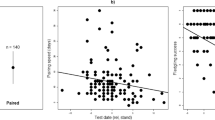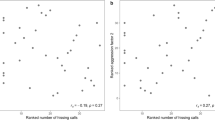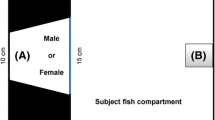Abstract
Males are dominant over females in many bird species. This may lead to male monopolisation of resources whenever food is scarce or clumped and secondarily to lower female survival rates. As a result of the consequent male-biased sex ratio in the adult population, competition may arise either (1) between males and females, as males attempt to exclude females from feeding patches, or (2) between males because females do not pose a competitive threat. We recorded agonistic interactions between males and females in wintering foraging flocks of serins (Serinus serinus) and siskins (Carduelis spinus) to test for inter-specific differences. Most of the aggressive interactions in serins were between males and females, whereas in siskins they were between males. We also compared sex ratios for each species during the winter, determined from separate trapping efforts over an 11-year period, to test whether the direction of aggression by males (i.e. male/male; male/female) relates to variations in female survival rates. The proportion of females was smaller in winter than in autumn for serins, but differences in siskins were negligible. Results are interpreted in relation to the social organization displayed by both species studied.

Similar content being viewed by others
References
Altmann SA, Altmann J (1977) On the analysis of rates of behaviour. Anim Behav 25:364–372
Andersson M (1994) Sexual selection. Princeton University Press, Princeton
Balph MH, Balph DF, Romesburg HC (1979) Social status signalling in winter flocking birds: an examination of a current hypothesis. Auk 96:78–93
Barta Z, Liker A, Möckel R (2004) The effects of predation risk on the use of social foraging tactics. Anim Behav 67:301–308
Bekoff M, Scott AC (1989) Aggression, dominance, and social organization in evening grosbeaks. Ethology 83:177–194
Benkman CW (1997) Feeding behavior, flock-size dynamics, and variation in sexual selection in crossbills. Auk 114:163–178
Breitwisch R (1989) Mortality patterns, sex ratios, and parental investment in monogamous birds. Curr Ornithol 6:1–50
Busse P (1984) Key to sexing and ageing of European passerines. Beitr Naturk Niedersachsens 37:1–224
Butcher GS, Rohwer SA (1989) The evolution of conspicuous and distinctive coloration for communication in birds. Curr Ornithol 6:51–108
Clutton-Brock TH (1986) Sex ratio variation in birds. Ibis 128:317–329
Conover WJ (1981) Rank transformations as a bridge between parametric and nonparametric statistics. Amer Stat 35:124–129
Conroy MJ, Senar JC, Domènech J (2002) Analysis of individual and time-specific covariate effects on survival and movements of Serinus serinus in northeastern Spain. J appl Stat 29:125–142
Domènech J, Senar JC (1998) Trap type can bias estimates of sex ratio. J Field Ornithol 69:380–385
Domènech J, Senar JC (1999) Are foraging serin Serinus serinus females more vigilant than males?: the effect of sex ratio. Ardea 87:277–284
Donald PF (2007) Adult sex ratios in wild bird populations. Ibis 149:671–692
Gowaty PA (1995) Sexual dialectics, sexual selection, and variation in mating behavior. In: Gowaty PA (ed) Feminism and evolutionary biology. Chapman & Hall, New York, pp 351–384
Gowaty PA (1996) Battles of the sexes and origins of monogamy. In: Black JM (ed) Partnerships in birds. Oxford Univ. Press, Oxford, pp 21–52
Hill GE, Montgomerie R, Roeder C, Boag P (1994) Sexual selection and cuckoldry in a monogamous songbird: implications for sexual selection theory. Behav Ecol Sociobiol 35:193–199
Keys GC, Rothstein SI (1991) Benefits and costs of dominance and subordinance in white-crowned sparrows and the paradox of status signalling. Anim Behav 42:899–912
Korsten P, Vedder O, Szentirmai I, Komdeur J (2007) Absence of status signalling by structurally based ultraviolet plumage in wintering blue tits (Cyanistes caeruleus). Behav Ecol Sociobiol 61:1933–1943
Lebreton JD, Pradel R, Clobert J (1993) The statistical analysis of survival in animal populations. Trend Ecol Evol 8:91–95
Marcelli M, Fusillo R, Boitani L (2003) Sexual segregation in the activity patterns of European polecats (Mustela putorius). J Zool 261:249–255
Metcalfe NB (1986) Variation in winter flocking associations and dispersion patterns in the turnstone Arenaria interpres. J Zool 209:385–403, Lond
Metcalfe NB, Thomson BC (1995) Fish recognize and prefer to shoal with poor competitors. Proc R Soc Lond B 259:207–210
Payevsky VA (1994) Age and sex structure, mortality and spatial winter distribution of siskins (Carduelis spinus) migrating through eastern Baltic area. Vogelwarte 37:190–198
Payevsky VA, Vysotsky VG, Yefremov VD, Markovets MY, Morozov YG, Shapoval AP (1997) Sex-specific survival rates in birds. Zh Obshch Biol 58:5–20
Popp JW (1988) Scanning behavior of finches in mixed-species groups. Condor 90:510–512
Ripoll J, Saldaña J, Senar JC (2004) Evolutionary stable transition rates in a stage-structured model. An application to the analysis of size distributions of badges of social status. Math Biosci 190:145–181
Rohwer S (2004) Using age ratios to infer survival and despotic breeding dispersal in hybridizing warblers. Ecology 85:423–431
Rohwer SA, Ewald PW (1981) The cost of dominance and advantage of subordination in a badge signaling system. Evolution 35:441–454
Ruckstuhl KE (2007) Sexual segregation in vertebrates: proximate and ultimate causes. Integr Comp Biol 47:245–257
Senar JC (1985) Interactional rules in captive siskins (Carduelis spinus). Misc Zool 9:347–360
Senar JC (1994) Vivir y convivir: la vida en grupos sociales. In: Carranza J (ed) Etología: Introducción a la ciéncia del comportamiento. Univ. of Extremadura, Cáceres, pp 205–233
Senar JC, Camerino M, Metcalfe NB (1989) Agonistic interactions in siskin flocks: why are dominants sometimes subordinate? Behav Ecol Sociobiol 25:141–145
Senar JC, Camerino M, Metcalfe NB (1990a) Familiarity breeds tolerance: the development of social stability in flocking siskins (Carduelis spinus). Ethology 85:13–24
Senar JC, Copete JL, Metcalfe NB (1990b) Dominance relationships between resident and transient wintering siskins. Ornis Scand 21:129–132
Senar JC, Camerino M, Metcalfe NB (1992) Fighting as a subordinate in finch flocks: escalation is effective but risky. Anim Behav 43:862–864
Senar JC, Camerino M, Metcalfe NB (1997) A comparison of agonistic behaviour in two Cardueline finches: feudal species are more tolerant than despotic ones. Etología 5:73–82
Shreeve DF (1980) Differential mortality in the sexes of the Aleutian gray-crowned rosy finch. Am Midl Nat 104:193–197
Slotow R, Rothstein SI (1995) Importance of dominance status and distance from cover to foraging white-crowned sparrows: an experimental analysis. Auk 112:107–117
Svensson L (1992) Identification guide to European passerines. Svensson, Stockholm
Whitehead H (2008) Analyzing animal societies. Quantitative methods for vertebrate social analyses. The University of Chicago Press, Chicago
Wiley RH (1990) Prior-residency and coat-tail effects in dominance relationships of male dark-eyed juncos Junco hyemalis. Anim Behav 40:587–596
Wolfenbarger LL (1999) Is red coloration of male Northern Cardinals beneficial during the nonbreeding season?: a test of status signaling. Condor 101:655–663
Zschille J, Stier N, Roth M (2010) Gender differences in activity patterns of American mink Neovison vison in Germany. Eur J Wildl Res 56:187–194
Acknowledgements
We thank Alex Middleton and Lluïsa Arroyo for suggestions to improve the paper. We are also grateful to José Luis Copete and Didac Valera for their help in field work, Lluïsa Arroyo for her help in the laboratory and Hermanitas de la Asunción for allowing us to work in their property. This is a contribution to research project CGL 2009-10652 from Ministerio de Ciencia y Tecnología, Spanish Research Council. Birds were handled with the permission of the Catalan Ringing Office (ICO) and the Departament de Medi Ambient, Generalitat de Catalunya.
Author information
Authors and Affiliations
Corresponding author
Rights and permissions
About this article
Cite this article
Senar, J.C., Domènech, J. Sex-specific aggression and sex ratio in wintering finch flocks: serins and siskins differ. acta ethol 14, 7–11 (2011). https://doi.org/10.1007/s10211-010-0084-3
Received:
Revised:
Accepted:
Published:
Issue Date:
DOI: https://doi.org/10.1007/s10211-010-0084-3




